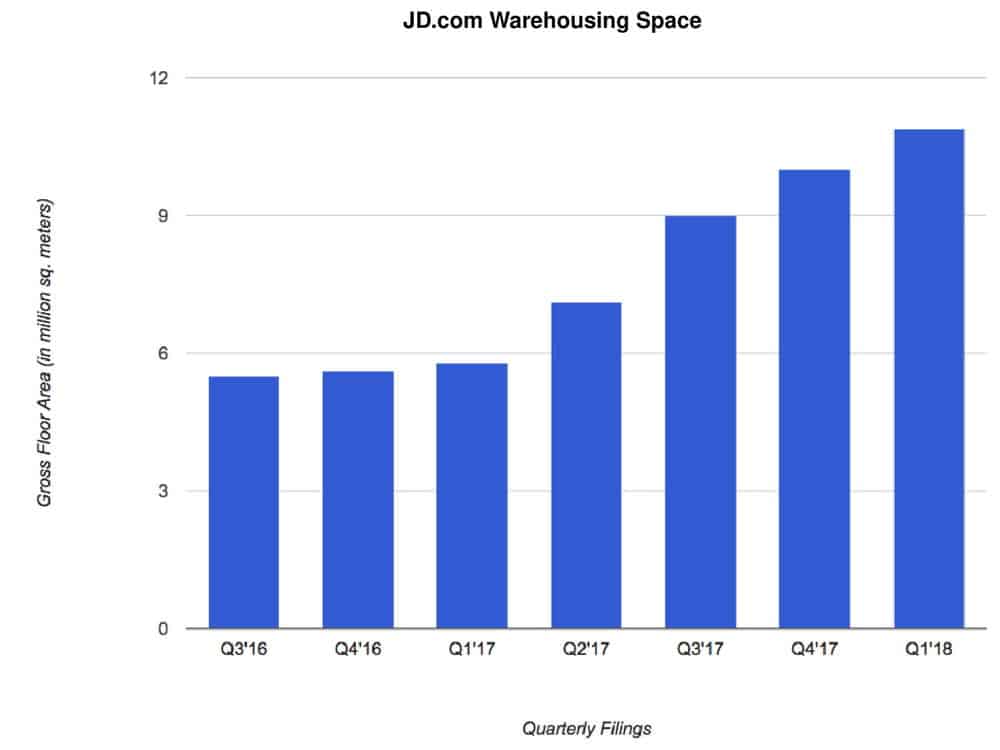
JD.com, the logistics major from China, has recently unveiled a warehouse that can handle 200,000 orders a day but employs just four people – with their jobs centered around servicing the robots that run the place. The fulfillment center built at Kunshan, on the outskirts of Shanghai, ushers in a new future to the Chinese e-commerce industry with JD.com confident on providing same-day delivery to even the remotest places across China, provided the order comes in before 11 AM for the day.
JD.com has been in a perpetual state of warehousing growth over the last few years, with a drastic increase in space from Q1 2017, when it had 5.8 million square meters of warehousing space which increased to 10.9 million square meters by Q1 2018 – a staggering 85% increase year-on-year.

The overarching investment in technology and space has reflected on its earnings, which show that the company is not as profitable as its rival Alibaba. But this does not look to be a cause of worry as the company is strengthening its logistics reach, which is its primary bedrock. “Everything is about scale. When you invest in technology, you don’t worry about spending money. You worry whether you can get to scale. When scale comes, profit will come,” said Chen Zhang, CTO of JD.com mirroring the principles by which Jeff Bezos runs Amazon.
China is a fertile land for logistics competition, as the consumeristic expectations of the Chinese e-commerce buyers are nearly trumping their Western counterparts. JD.com and Alibaba understand that to make supply chains tighter and faster, it is vital to remove the human quotient from redundant tasks, which when relegated to automated robots would quicken the pace of “fulfillment.”
“Once packages are taken off trucks at one side of the Kunshan facility, they’re loaded onto a complex network of automated machinery, where fast-moving, automated conveyors zip each box around,” JD.com said in a statement. “Image scanners can check the packages in microseconds, while JD’s smart logistics system calculates where the packages should be dropped off. The packages are grouped by region into large bins, which are picked up by driverless forklifts and brought to the corresponding truck for delivery to the right destination.”
China leads the world in year-on-year e-commerce growth, with online retailing expected to grow from 17% of total retail sales in 2017 to 25% by 2020. JD.com has a heavy presence in the megacities like Shanghai, Guangzhou, and Beijing, but the company is now opening up to the potential of smaller cities and the remote countryside situated in the deep interior pockets of the country.
As these regions are sparsely connected by road, last-mile delivery could be a problem. And to address this predicament, JD.com has already introduced a fleet of drones, that can fly at 60 miles an hour while carrying packages weighing over 60 pounds. The company is also developing drones that can carry a maximum of one ton, but is still stuck on battery complications, as the cost of battery still outweighs the fast-delivery edge. “Once the industry has solved the battery issue, we believe at that time our technology will be mature, and we can fully operationalize our drone delivery program,” said Zhang.
To deliver to the rural areas of China, JD.com connects with a delivery aide who lives in ground zero and works as a local distributor for the region. The drones are flown into the backyard of the delivery guy, who can collect the packages and set off to deliver them door to door.
With automation, it is quite evident that hundreds of thousands of worker jobs would be lost, and this is particularly felt in China as it holds the largest population in the world. But amidst the negative sentiment prevailing across its workforce, JD.com assured that though the present jobs would likely be phased out over time, new jobs would crop up – like observing drones and servicing warehousing robots.
Stay up-to-date with the latest commentary and insights on FreightTech and the impact to the markets by subscribing.







